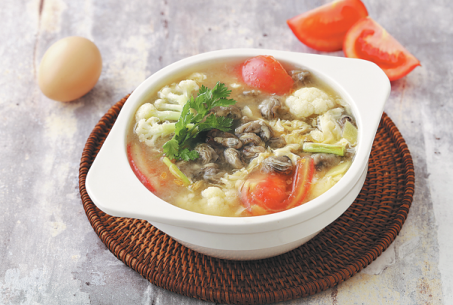Restaurant shells out to celebrate oyster season
By Li Yingxue (China Daily) Updated: 2020-01-03 00:00At 6 o'clock in the morning, a fishing boat sets sail from the seashore in Jiangkou county, Putian city, Fujian province.
Half an hour later, it drops anchor amid a flotilla of plastic barrels.
Each barrel houses a rope of oysters, waiting to be gathered by the fishermen, and the sea air is rich with the scent of the mature mollusks-fresh and salty, with a hint of sweetness. For more than 300 days, the oysters have been nurtured by perfect conditions, and now is the right time to reap the harvest, a season that will last until March.
It's noon when the fishermen return to shore with their boat fully loaded. A dozen middle-aged women line the beach to greet them as they land-or perhaps more precisely, wait for the oysters.
With a small knife in one hand and a thick glove on the other, each woman can shuck two to three oysters a second. Over the course of an afternoon, a single one of these industrious women can shuck hundreds of kilograms of oysters that are then put into small barrels and sent across China to the branches of Putien restaurant, some of which will arrive in Beijing the next day.
Until the end of the season, every branch of Putien will be highlighting six oyster dishes using the extricated mollusks.
"It's the third year that we are hosting a Putian oyster season at our restaurants," says Yu Jing, brand director of the restaurant chain. "In 2018, we consumed 78 metric tons of fresh oysters."
According to Yu, there are many coastal areas breeding oysters in China, but Fujian has become, regionally, the largest domestic producer because of its long coastline and ideal climate.
"The salinity of the seawater in Putian is in line with the global average, while the temperature is between 23 C and 28 C, allowing for the cultivation of oysters with a less fishy smell and a sweeter flavor," she says.
"What's magic about breeding oysters is that they don't need to be fed. They grow by themselves by absorbing the bacteria and other forms of nutrition from the sea," Yu says.
In most cases, baby oysters are attached to the rope and lowered into the sea around April and May. They are usually ready for harvest after 180 days, but Putien only collects the oysters that have been cultivated for more than 300 days.
According to chef Li Wenbo, who was born and raised in Putian, the six special oyster season dishes are a mixture of traditional Putian dishes and creative, contemporary concoctions developed by the chefs at Putien.
"Oysters are a typical ingredient of Putian, and they're much smaller, but fresher and sweeter than their French counterparts," Li says.
The most traditional preparation is oyster egg pancakes-the oyster is pan-fried with the egg pancake mix for five minutes until the edge of the pancake is crisp and the oyster inside is cooked.
"The pot must be hot and the oil must be cold when it's added. That's the trick to making the pancake," Li says.
To pair with the pancake, Li whips up a special chili sauce, which is an in-house recipe featuring dozens of spices.
Oyster soup is another traditional dish that Li's family would make at home each winter. A spoonful of white vinegar and ground pepper is the magic ingredient that gives the soup a pop of flavor.
Nori and rice noodle are also signature ingredients of Putian. Adding nori to fried oyster egg pancake makes the dish softer and fresher. This year, Putien launches a new dish: Oyster rice noodle and egg pancake-adding the rice noodle, which is as thin as hair, gives the pancake an appealing toothsome texture.
"I grew up eating these dishes and now I'm proud to be able to share the flavors of my youth with others," he says.

- 'Cooperation is complementary'
- Worldwide manhunt nets 50th fugitive
- China-Japan meet seeks cooperation
- Agency ensuring natural gas supply
- Global manhunt sees China catch its 50th fugitive
- Call for 'Red Boat Spirit' a noble goal, official says
- China 'open to world' of foreign talent
- Free trade studies agreed on as Li meets with Canadian PM Trudeau
- Emojis on austerity rules from top anti-graft authority go viral
- Xi: All aboard internet express











